山东师范大学2011年《908外语教学理论基础》考研专业课真题试卷
2011学科教学(英语)908英语教育理论

3.Nevile Grant suggests four alternatives when the teacher decides the textbook is not appropriate.They are:_______7________,replace the textbook with one of the teacher’s own,__________8___________,and________9__________.
1.According toGardnerand Lambert,there are two kinds of motivations.What are they?Please explain.How important is the students’motivation in language learning?
.Judge whether each of the following statements is true or false.Put a T for true or F for false.(10 points)
1.The theory of learning underlying Audiolingualism is behaviorism.
(10 points)
You should answer this question based on your ownunderstanding and the ideasin the book.
2.What questions do we need to ask for each activity we intend to do is the lesson?
山东师范大学外国语学院908外语教学《理论基础》[专业硕士]历年考研真题及详解专业课考试试题
![山东师范大学外国语学院908外语教学《理论基础》[专业硕士]历年考研真题及详解专业课考试试题](https://img.taocdn.com/s3/m/dba5d489e2bd960590c677eb.png)
目 录2011年山东师范大学908外语教学理论基础考研真题及详解2012年山东师范大学908外语教学理论基础考研真题及详解2013年山东师范大学908外语教学理论基础考研真题及详解2014年山东师范大学908外语教学理论基础考研真题及详解2015年山东师范大学908外语教学理论基础考研真题及详解2016年山东师范大学908外语教学理论基础考研真题及详解2011年山东师范大学908外语教学理论基础考研真题及详解I. Explain the following terms. (共7道小题,每题5分,共计35分)1.Deductive teaching【答案】Deductive teaching is a more traditional form of teaching. In deductive teaching you typically provide information (lecture), share specific examples of the concept or skills being taught, then, allow students to practice the skill being taught. This is a more teacher-centered model of teaching that is rule driven. Some of the positives of this method are that it is time saving and gets to the point of the lesson easily.2.Positive transfer【答案】Positive transfer is where the two habits share common aspects, such the knowing one will help with learning the other. It may help or facilitate language learning in another later situation, and may occur when both the native language and the target language have the same form.3.Reflective teaching【答案】A reflective approach to teaching is one in which teachers and student teachers collect data about teaching, examine their attitudes, beliefs, assumptions and teaching practices, and use the information obtained as a basis for critical reflection about teaching.4.Communicative strategies【答案】Communicative strategies are defined as mutual attempts of two interlocutors to agree on a meaning in situations where requisite meaning strategies do not seem to be shared. From the perspective of error resources, CS is defined as the process of inter-lingual transfer and the context of learning as a learner tries to get a message through to a hearer or reader. 5.Student-centered teaching【答案】Student-centered teaching aims to develop learner autonomy and。
2011年考研英语真题答案及解析
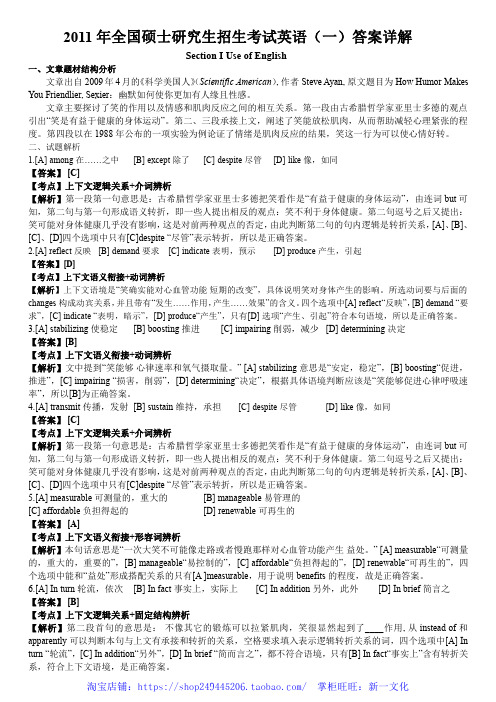
2011年全国硕士研究生招生考试英语(一)答案详解Section I Use of English一、文章题材结构分析文章出自2009年4月的《科学美国人》(Scientific American),作者Steve Ayan,原文题目为How Humor Makes You Friendlier,Sexier:幽默如何使你更加有人缘且性感。
文章主要探讨了笑的作用以及情感和肌肉反应之间的相互关系。
第一段由古希腊哲学家亚里士多德的观点引出“笑是有益于健康的身体运动”。
第二、三段承接上文,阐述了笑能放松肌肉,从而帮助减轻心理紧张的程度。
第四段以在1988年公布的一项实验为例论证了情绪是肌肉反应的结果,笑这一行为可以使心情好转。
二、试题解析1.[A]among在……之中[B]except除了[C]despite尽管[D]like像,如同【答案】[C]【考点】上下文逻辑关系+介词辨析【解析】第一段第一句意思是:古希腊哲学家亚里士多德把笑看作是“有益于健康的身体运动”,由连词but可知,第二句与第一句形成语义转折,即一些人提出相反的观点:笑不利于身体健康。
第二句逗号之后又提出:笑可能对身体健康几乎没有影响,这是对前两种观点的否定,由此判断第二句的句内逻辑是转折关系,[A]、[B]、[C]、[D]四个选项中只有[C]despite“尽管”表示转折,所以是正确答案。
2.[A]reflect反映[B]demand要求[C]indicate表明,预示[D]produce产生,引起【答案】[D]【考点】上下文语义衔接+动词辨析【解析】上下文语境是“笑确实能对心血管功能短期的改变”,具体说明笑对身体产生的影响。
所选动词要与后面的changes构成动宾关系,并且带有“发生……作用,产生……效果”的含义。
四个选项中[A]reflect“反映”,[B]demand“要求”,[C]indicate“表明,暗示”,[D]produce“产生”,只有[D]选项“产生、引起”符合本句语境,所以是正确答案。
山东师范大学2011年硕士研究生入学考试(333教育综合)真题

山东师范大学2011年硕士研究生入学考试(333教育综合)真题
一、名词解释5*6=30分
1、教育目的
2、教育的社会变迁功能
3、学校管理
4、教学
5、《理想国》
二、简答
1、简述先秦时期的私学兴起及其作用
2、简述杜威关于教育本质的认识
3、简述夸美纽斯在教育史上的贡献
4、简要叙述清末的四次留学
5、简述教育的经济功能
6、简述晏阳初关于“四大教育”的思想
三、论述
1、依据所掌握的的教育理论和自身的教学实践,谈谈我们新一轮基础教育改革对老师提出了哪些新的要求?
2、试述影响问题解决的因素以及教育实际中问题解决能力的培养。
907真题(1)山东师范大学2010-2016年考研真题
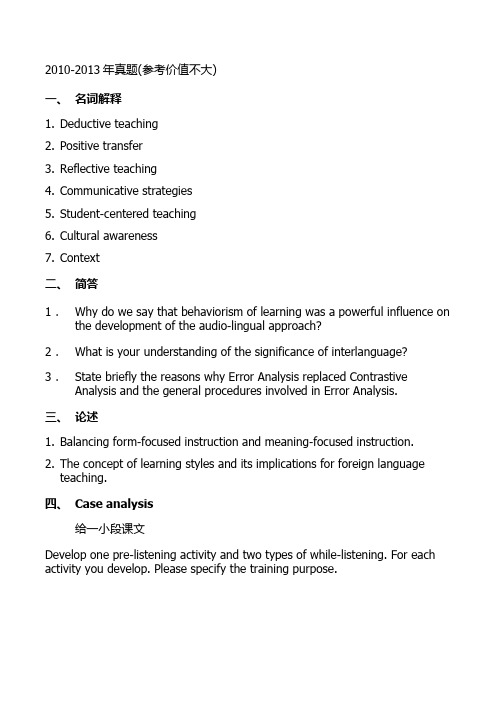
2010-2013年真题(参考价值不大)一、名词解释1.Deductive teaching2.Positive transfer3.Reflective teachingmunicative strategies5.Student-centered teaching6.Cultural awareness7.Context二、简答1.Why do we say that behaviorism of learning was a powerful influence on the development of the audio-lingual approach?2.What is your understanding of the significance of interlanguage? 3.State briefly the reasons why Error Analysis replaced Contrastive Analysis and the general procedures involved in Error Analysis.三、论述1.Balancing form-focused instruction and meaning-focused instruction.2.The concept of learning styles and its implications for foreign languageteaching.四、Case analysis给一小段课文Develop one pre-listening activity and two types of while-listening. For each activity you develop. Please specify the training purpose.一、Explain the following 7 terms.1.Interlanguage2.Cognitive style3.Affective filtermunicative language teaching5.Top-down information processing6. Action researchnguage aptitude二、Answer the following question briefly.1. How did the behaviorists explain the language learning process?2.What is your understanding of transfer? Please use concrete examples to illustrate learner’s L1 influence on the learning of a foreign language.3.What is your understanding of the relationship between motivation and language learning achievement.三、Writ a discussion on each of the following subjects.1.First language transfer and errors in language learning.2.The “Zone of Proximal Development” theory and its implications for foreign language teaching.四、Case analysis.两段英文对话1.Which text is in authentic language and which is not? Decide and thenstate your reasons.2.Why is authentic material recommended in language teaching class?一、名词解释1.Speech act2.Negative transfer3.Task-based language teaching4.Fossilization5.Syllabus6.Acculturation7.Learning strategies二、简答1.State briefly how Contrastive Analysis was conducted and the usual procedures involved in Contrastive Analysis.2.State briefly the Input Hypothesis and its implications for language teaching.3.What is the interaction hypothesis in language learning?三、论述1.Input and output in foreign language learning.2.Interactive language processing and its implications for the teaching of foreign language reading.四、Case analysis.How to treat student’s errors.2014-2016年真题一定要好好看,最后一个题没有太大参考价值每年考试的内容都不一样。
山东师范大学美术学院908美术教学论[专业硕士]历年考研真题专业课考试试题
![山东师范大学美术学院908美术教学论[专业硕士]历年考研真题专业课考试试题](https://img.taocdn.com/s3/m/d9fdea9b5727a5e9846a6153.png)
2015年山东师范大学美术学院909美术教学论[专业硕士]考研真题(缺教 材) 2016年山东师范大学美术学院909语文教学论[专业硕士]考研真题 2017年山东师范大学美术学院911美术教学论[专业硕士]考研真题 2018年山东师范大学美术学院911美术教学论[专业硕士]考研真题
2015年山东师范大学美术学院909 美术教学论[专业硕士]考研真题
(09 语文教学论[专业硕士]考研真题
2017年山东师范大学美术学院911 美术教学论[专业硕士]考研真题
2018年山东师范大学美术学院911 美术教学论[专业硕士]考研真题
山东师范大学2010-2018历年教育硕士333真题汇编
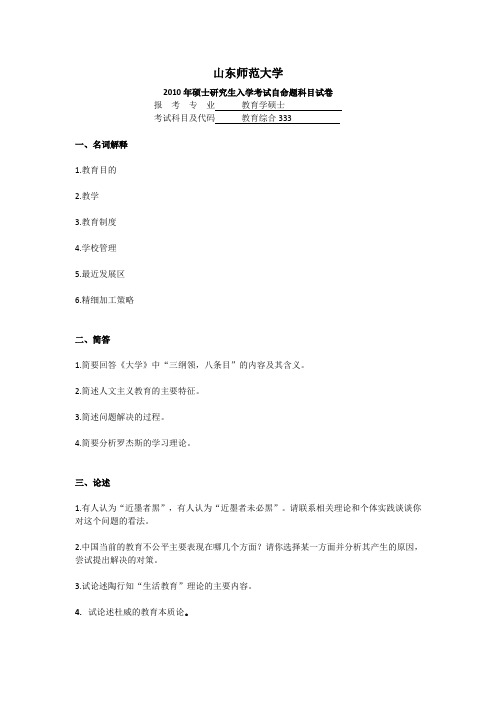
2010年硕士研究生入学考试自命题科目试卷报考专业教育学硕士考试科目及代码教育综合333一、名词解释1.教育目的2.教学3.教育制度4.学校管理5.最近发展区6.精细加工策略二、简答1.简要回答《大学》中“三纲领,八条目”的内容及其含义。
2.简述人文主义教育的主要特征。
3.简述问题解决的过程。
4.简要分析罗杰斯的学习理论。
三、论述1.有人认为“近墨者黑”,有人认为“近墨者未必黑”。
请联系相关理论和个体实践谈谈你对这个问题的看法。
2.中国当前的教育不公平主要表现在哪几个方面?请你选择某一方面并分析其产生的原因,尝试提出解决的对策。
3.试论述陶行知“生活教育”理论的主要内容。
4.试论述杜威的教育本质论。
2011年硕士研究生入学考试自命题科目试卷报考专业教育学硕士考试科目及代码教育综合333一、名词解释1、课程2、三纲领八条目3、苏格拉底法4、德育二、简答1、简述稷下学宫的性质与特点2、简述德育的政治功能。
3、简述裴斯泰洛齐的“教育心理学化”理论。
4、简要分析影响自我效能感感形成的因素。
5、简述陶行知生活教育的主要内容。
6、简述皮亚杰认知发展阶段理论。
三、论述1、中国当前的教育不公平主要表现在哪几个方面?请您选择某一方面并分析其产生的原因,尝试提出解决的对策。
2、什么是教育的社会制约性和相对独立性?怎样协调二者的关系?2012年硕士研究生入学考试自命题科目试卷报考专业教育学硕士考试科目及代码教育综合333一、名词解释教育心理学化"三纲领八条目""稷下学宫"二、简答题教育的政治功能"稷下学宫"的性质和特点德育的功能三、论述题当今中国教育不公平现象例举,并就其中一例说明出现的原因以及解决的措施教育的社会制约性和独立性,以及两者的关系2013年硕士研究生入学考试自命题科目试卷报考专业教育学硕士考试科目及代码教育综合333一、名词解释1、中体西用2、朱子读书法3、京师同文馆4、导生制5、学习风格二、简答题1、北宋的三次兴学及其结果2、学生的学习特点3、人文主义教育的主要特征4、要素主义教育学派的理论5、教学过程的性质6、问题解决的含义及心理过程三、论述题1、结合实际谈谈教师应具备哪些素质?应该怎样培养?2、评价教育目的价值取向中的个人本位论和社会本位论2014年硕士研究生入学考试自命题科目试卷报考专业教育学硕士考试科目及代码教育综合333一、名词解释(5*4=20)1、综合实践活动2、学园3、骑士教育4、潜伏学习二、辨析题(10*4=40)1、人的身心发展的不平衡要求教育要循序渐进2、学习引起个体的行为发生变化,因此,一个人行为发生了变化可以判定发生了学习3、教育要求促进学生的全面发展,.......学生的个性发展,因此,促进学生的全面发展与个性发展是相对立的4、卡特尔认为,流体智力是在实践中获得的,因此人的一生流体智力都是在生长的三、简答题(10*6=60)1、政治经济制度对教育的影响2、教师劳动的特点3、清朝末期的教育改革4、《国防教育法》的主要内容及意义5、改造主义的主要观点6、维果茨基的理论中,低级心理机能向高级心理机能的转化中发生了哪些变化?四、分析题(15*2=30)1、教育中直接经验与间接经验的关系2、孟子和荀子的教育思想的不同2015年硕士研究生入学考试自命题科目试卷报考专业教育学硕士考试科目及代码教育综合333一、名词解释1.个人本位论2.三舍法3.学在官府4.智者二、辨析题1“近朱者赤近墨者黑??,所以说明环境在人的身心发展中起决定作用2.教师劳动具有专业性3.法家的绝对“性恶论”否定了教育的价值4.经典性条件反射和操作性条件反射没有实质性的区别三、简答1.现代教育的特征2.学科课程的特点3.汉代“独尊儒术”文件政策4.巴特勒法案5.奥苏伯尔的认知同化理论6.简述规范学习的心里过程四、论述题1.如何理解教学中的掌握知识与发展能力的关系2.对卢梭的自然主义教育进行述评2016年硕士研究生入学考试自命题科目试卷报考专业教育学硕士考试科目及代码教育综合333一、名词解释1、活动课程2、致良知3、大学区制4、自我效能感二、辨析1、教育目的是人制定,所以是主观的2、教师在教学过程中担任多种角色3、新教育运动是19世纪末20世纪初兴起于美国的教育革新运动4、场独立型的人适合学习人文知识场依存型的人适合学习数理知识三、简答1、教育的政治功能2、教学的任务3、九品中正制4、基督教教育的特点5、严复的三育论6、明治维新的教育改革四、论述1、论述教师主导与学生主动性的关系2、联系实际说明促进学习迁移的措施2017年硕士研究生入学考试自命题科目试卷报考专业教育学硕士考试科目及代码教育综合333一、名词解释1、上位学习2、成就动机3、教学评价4、苏湖教学法5、教育准备生活6、平民教育思潮二、简答题1、奥苏泊尔有意义学习条件2、文化对于教育的制约和影响三、简述1、夸美纽斯的教育思想,2、课程目标的几种表述形式四、论述1、结合材料评述教育对人发展的作用2、论述苏格拉底法课程目标的几种表述形式五、辨析题1、蔡元培的思想自由,兼容并包是无所不包2、课程内容即教材内容3、智力高的人创造力也高2018年硕士研究生入学考试自命题科目试卷报考专业教育学硕士考试科目及代码教育综合333一、名词解释1.教育中介系统2.认知风格3.社会本位论4.正迁移5.课程内容6、庚款兴学二、简答题1.中世纪大学的意义2.察举制与九品中正制异同3.直接经验和间接经验关系4.影响问题解决的因素5.永恒主义教育的原则6.理论联系实际原则三、辨析题1.负强化就是惩罚2.法国教育体制是地方分权式3.人的发展速度不同说明人的发展的阶段性四、论述题1.教师必备的素养2.王守仁的儿童教育思想。
2011年山东师范大学908外语教学理论基础考研真题及详解【圣才出品】

2011年山东师范大学908外语教学理论基础考研真题及详解I. Explain the following terms. (共7道小题,每题5分,共计35分)1. Deductive teaching【答案】Deductive teaching is a more traditional form of teaching. In deductive teaching you typically provide information (lecture), share specific examples of the concept or skills being taught, then, allow students to practice the skill being taught. This is a more teacher-centered model of teaching that is rule driven. Some of the positives of this method are that it is time saving and gets to the point of the lesson easily.2. Positive transfer【答案】Positive transfer is where the two habits share common aspects, such the knowing one will help with learning the other. It may help or facilitate language learning in another later situation, and may occur when both the native language and the target language have the same form.3. Reflective teaching【答案】A reflective approach to teaching is one in which teachers and student teachers collect data about teaching, examine their attitudes, beliefs, assumptions and teaching practices, and use the information obtained as a basis for criticalreflection about teaching.4. Communicative strategies【答案】Communicative strategies are defined as mutual attempts of two interlocutors to agree on a meaning in situations where requisite meaning strategies do not seem to be shared. From the perspective of error resources, CS is defined as the process of inter-lingual transfer and the context of learning as a learner tries to get a message through to a hearer or reader.5. Student-centered teaching【答案】Student-centered teaching aims to develop learner autonomy and independence by putting responsibility for the learning path in the hands of students. Student-centered instruction focuses on skills and practices that enable lifelong learning and independent problem-solving. Student-centered teaching emphasizes the learner’s critical role in constructing meaning from new information and prior experience.Student-centered teaching puts students’ interests first, acknowledging student voice as central to the learning experience. In a student-centered teaching pace, students choose what they will learn, how they will learn, and how they will assess their own learning. This is in contrast to traditional education, also dubbed “teacher-centered learning”, which situates the teacher as the primarily “active” role while students take a more “passive”, receptive role. In a teacher-centeredclassroom, teachers choose what the students will learn, how the students will learn, and how the students will be assessed on their learning. In contrast, student-centered teaching requires students to be active, responsible participants in their own learning and with their own pace of learning.6. Cultural awareness【答案】Cultural Awareness is the foundation of communication and it involves the ability of standing back from ourselves and becoming aware of our cultural values, beliefs and perceptions.7. Context【答案】The relevant constraints of the communicative situation that influence language use, language variation, and discourse summary.II. Write brief answers to the questions. (共3道小题,每题15分,共计45分)1. Why do we say that behaviorism of learning was a powerful influence on the development of the audio-lingual approach?【答案】The audio-lingual approach is a method of foreign or second language teaching which emphasizes the teaching of speaking and listening before reading and writing. Behaviorism of learning is the basis of the audio-lingual approach. Behaviorism proposes that learning language is a process of habit formation, which includes three stages: imitation, reinforcement and formation. It processes thatcertain traits of living things, and in this case humans could be trained through a system of reinfourcement—correct use of a trait would receive positive feedback while incorrect use of that trait would receive negative feedback. Audio-lingual approach follows such process. Students are asked to do lots of drills of speaking and listening and to imitate. And the the habits about language are formed.2. What is your understanding of the significance of inter-language?【答案】Proposed by Selinker, the concept of inter-language was established as learner’s independent system of the second language, which is neither the native language nor the second language, but a continuum or approximation from one extreme of mother-tongue to the other of the second language. What learners prodece, correct or wrong, are evidence of the approximation from their language to the target language, it is imperfect compare with the target language either. Therefore, inter-language can help learners realize the gap between their own language and the target language.Inter-language can help language learners and teachers understand the relationship between native language, inter-language and foreign language. The formation of inter-language is affected by both native language and target language, their relationship is more complicated. It seems that inter-language detives from native language and target language, but is inferior to the latter.Inter-language also sheds lights on latent psychological structure. Relevant behavioral events in a psychology of second-language learning should be madeidentified with the aid of theoretical constructs which assume the major features of the psychological structure of an adult whenever he attempts to understand SL sentences or to produce them, we assume that there is such a psychological structure and that it is latent in the brain, activitated when one attempts to learn a second language.On the other hand, inter-language is comparatively independent from native language and with the help of inter-langue, the native language can be predicted and analysed.3. State briefly the reasons why Error Analysis replaced Contrastive Analysis and the general procedures involved in Error Analysis.【答案】There are some reasons which cause Contrastive Analysis to be replaced. Firstly, there were doubts concerning the ability of CA to predict errors in language learning. It was shown in research that not all errors were caused by the interference by the mother tongue. It is obvious that the psychological and linguistic basis of CA is clearly defective, because it is based on behaviorism and structuralism. Secondly, there were a number of theoretical criticisms regarding the feasibility of comparing languages and the methodology of contrastive attacked by Chomsky and others. And the terms “stimulus”, “response”, “reinforcement”were rejected as an inadequate explanation of language learning. In addition to this, there were objections to the validity of equationg difference with difficulty on the one hand and difficulty with error on the other. Thirdly, there were doubts aboutwhether CA had any practical worth to language teaching. CA studies concentrated largely on grammatical aspects—the phonological level, the morphemic level and the syntactical level. There is practically little contrastive analysis above the sentence level, let alone the textual or discourse level. In addition, if a majority of learner errors are not caused by interference, then CA is of limited value. However, the main doubt about CA from a pedagogic point of view has arisen from the chaning attitudes to the role of errors in language learning. CA was based on the need to avoid error, but if error is seen as a positive aspect—a necessary developmental process of language learning, then why should we devise a teaching program to prevent it?The procedure of error analysis consists of the following steps:(1) Recognition. Dealing with a sentence produced by the language learner, we should first ask whether the sentence is grammatically correct. If the answer is negative, then errors exist. If the answer is positive, then we further check whether the sentence is appropriate in the communicative context. A negative answer indicates a mistake.(2) Description. If the erroneous sentence is intelligible, we compare it with the correct sentence produced by a native speaker and list the errors and mistakes. If the meaning of the sentence is not clear, we may refer to the learner’s native language to find out what he means and carry out a contrastive analysis. Taking into consideration the use of language in social contexts, we can describe mistakes as well as errors.。
山东师范大学教育学部909计算机基础[专业硕士]历年考研真题专业课考试试题
![山东师范大学教育学部909计算机基础[专业硕士]历年考研真题专业课考试试题](https://img.taocdn.com/s3/m/dbd1da1d1a37f111f0855b67.png)
2015年山东师范大ቤተ መጻሕፍቲ ባይዱ教育学部910 计算机基础[专业硕士]考研真题
2016年山东师范大学教育学部910 计算机基础[专业硕士]考研真题
2017年山东师范大学教育学部912 计算机基础[专业硕士]考研真题
2018年山东师范大学教育学部912 计算机基础[专业硕士]考研真题
目 录
2010年山东师范大学教育学部计算机基础[专业硕士]考研真题 2011年山东师范大学教育学部910计算机基础[专业硕士]考研真题 2012年山东师范大学教育学部910计算机基础[专业硕士]考研真题 2013年山东师范大学教育学部910计算机基础[专业硕士]考研真题 2014年山东师范大学教育学部909计算机基础[专业硕士]考研真题 2015年山东师范大学教育学部910计算机基础[专业硕士]考研真题 2016年山东师范大学教育学部910计算机基础[专业硕士]考研真题 2017年山东师范大学教育学部912计算机基础[专业硕士]考研真题 2018年山东师范大学教育学部912计算机基础[专业硕士]考研真题
2010年山东师范大学教育学部计 算机基础[专业硕士]考研真题
2011年山东师范大学教育学部910 计算机基础[专业硕士]考研真题
2012年山东师范大学教育学部910 计算机基础[专业硕士]考研真题
2013年山东师范大学教育学部910 计算机基础[专业硕士]考研真题
2014年山东师范大学教育学部909 计算机基础[专业硕士]考研真题
2011年各大高校教育硕士考研【333教育综合】考研真题试题(经典14套)
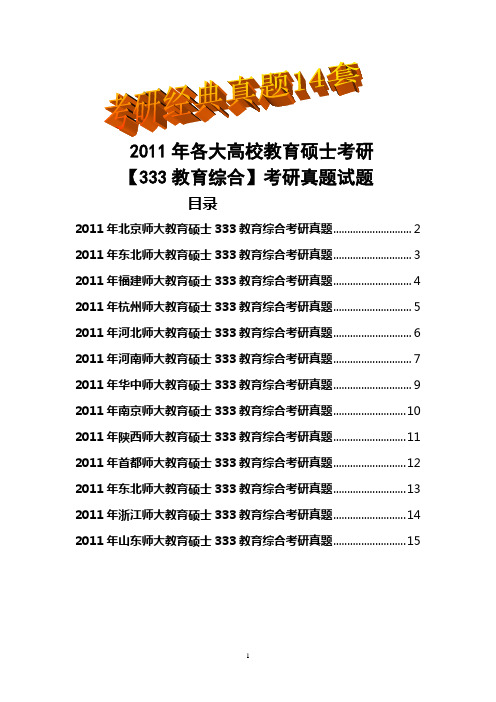
2011年各大高校教育硕士考研【333教育综合】考研真题试题目录2011年北京师大教育硕士333教育综合考研真题 (2)2011年东北师大教育硕士333教育综合考研真题 (3)2011年福建师大教育硕士333教育综合考研真题 (4)2011年杭州师大教育硕士333教育综合考研真题 (5)2011年河北师大教育硕士333教育综合考研真题 (6)2011年河南师大教育硕士333教育综合考研真题 (7)2011年华中师大教育硕士333教育综合考研真题 (9)2011年南京师大教育硕士333教育综合考研真题 (10)2011年陕西师大教育硕士333教育综合考研真题 (11)2011年首都师大教育硕士333教育综合考研真题 (12)2011年东北师大教育硕士333教育综合考研真题 (13)2011年浙江师大教育硕士333教育综合考研真题 (14)2011年山东师大教育硕士333教育综合考研真题 (15)2011年北京师大教育硕士333教育综合考研真题一、名词解释:(6*5分)1鸿都门学2中体西用3最近发展区4元认知策略5苏格拉底法6道尔顿制二、简答:(4*10分)1试评“环境决定论”2学校教育中怎样培养学生创造力3德育的疏导原则4教育为什么要“以人为本”三、分析:(4*20分)1蔡元培的“思想自由”“兼容并包”原则以及其对北大的改革2教学原则中的科学性与思想性统一原则3诊断性评价、形成性评价、终结性评价的内涵4杜威教育思想2011年东北师大教育硕士333教育综合考研真题教育学原理1. 简要回答教学过程应处理好的几种关系(10分)2. 简要回答我国教育目的的基本精神(10分)3. 论影响人身心发展的因素及其各自作用(10分)4. 列出我国基础教育中存在的主要问题两例,并就其一例做深入剖析(20分)中外教育史一、名词解释(每个5分,共20分)1.有教无类2.五育并举的教育方针3.苏格拉底法4.《初等教育法》二、论述题(每小题20分,共计40分)1.试论《学记》在教育管理和教学论上的贡献2.试论20世纪60年代美国中小学的课程改革教育心理学一、名词解释(每个5分,共10分)1.概括化理论2.努力管理策略二、简答题(每个10分,共计20分)1.简述奥苏伯尔的有意义接受说2.简述成败归因理论2011年福建师大教育硕士333教育综合考研真题一、名词解释(6*5=3U)1.社会流动功能2.颜氏家训3.中体西用4.昆西教学法5.课程标准二、简答题(10*4=4U)1.课程内容是什么,课程内容的逻辑组织形式是什么2.现代教育的趋势和特点3.自我教育能力的构成要素以及在德育过程中的作用.三、论述题(2U*4=8U)1.结合自己的教育经历,根据教师的劳动特点,谈谈合格班土任的素质要求2.简述裴斯泰洛齐教g心理学化思想3.评述1922年新学制4.根据教育实践论述如何培养学生的创造性2011年杭州师大教育硕士333教育综合考研真题一、名词解释1学校教育2教育目的的社会本位论3苏格拉底法4贝尔-----兰卡斯特制5教学做合一6《学记》二、简答1简述教育的相对独立性2影响问题解决的主要因素有哪些?3简述书院教育的特点。
山师语言学真题及答案解析
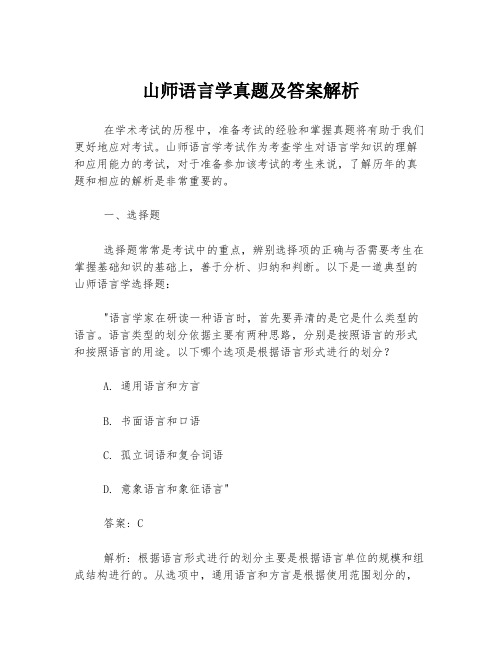
山师语言学真题及答案解析在学术考试的历程中,准备考试的经验和掌握真题将有助于我们更好地应对考试。
山师语言学考试作为考查学生对语言学知识的理解和应用能力的考试,对于准备参加该考试的考生来说,了解历年的真题和相应的解析是非常重要的。
一、选择题选择题常常是考试中的重点,辨别选择项的正确与否需要考生在掌握基础知识的基础上,善于分析、归纳和判断。
以下是一道典型的山师语言学选择题:"语言学家在研读一种语言时,首先要弄清的是它是什么类型的语言。
语言类型的划分依据主要有两种思路,分别是按照语言的形式和按照语言的用途。
以下哪个选项是根据语言形式进行的划分?A. 通用语言和方言B. 书面语言和口语C. 孤立词语和复合词语D. 意象语言和象征语言"答案: C解析: 根据语言形式进行的划分主要是根据语言单位的规模和组成结构进行的。
从选项中,通用语言和方言是根据使用范围划分的,书面语言和口语是根据使用环境划分的,意象语言和象征语言是根据语义划分的,而孤立词语和复合词语正是根据语言单位的规模和组成结构划分的。
二、解答题解答题是考查学生对语言学知识进行应用和分析的重要方式。
山师语言学考试常常涉及到从实际语言中挖掘语言现象的能力,以下是一道典型的山师语言学解答题:"在语言学上,有些语言现象是同一现象的两种不同形式,这是从不同的角度对待同一个事物或现象的结果,正因为如此,会有人提出相同的语言学观点却提供不同的论据。
请你列举一个这样的现象,并简要解释不同形式和不同论据背后的原因。
答案: 语言变异和语言变体解析: 语言变异是指同一种语言在不同区域或社会群体中,因为环境和社会因素的差异导致的语音、词汇和语法等方面的差异。
语言变体则指的是在同一个社会群体中,由于个体差异、地域差异或社会差异所致的语言变化。
这两种现象都是对语言多样性的不同切入点,因此在观察角度和理论解释上会有所差异。
例如,一个观点认为语言变异是源于语言隔离,而语言变体则是源于社会角色的不同。
